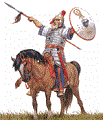Ramses II
Magister Militum

Inscrit le: 17 Juil 2015
Messages: 1236
Localisation: London
|
 Posté le: Mar Mar 15, 2016 10:07 am Sujet du message: Can supporting units change position Posté le: Mar Mar 15, 2016 10:07 am Sujet du message: Can supporting units change position |
 |
Player âAâ has a line of HI in an open battlefield, the end of which is being outflanked by mobile forces of player âBâ.
Defending this open flank, player âAâ has units of Light Infantry, Heavy Spear and Light cavalry in melee with a Heavy Chariot(a) and two Light cavalry units of player "B".
Player âBâ has charged units into the front of the enemy's main battle line overlapping the end unit. He has also got a Heavy Chariot(b) attacking the flank of the end unit of Heavy Infantry.
Initial position:-
. . LC =>
. . LC=><=LC
CH(a)=><=HS . . . . . <- Player "A" units defending the flank
. . . . . . <=LI
. . . . . CH(b)=>HI HI HI HI HI . . . <- Player "A" main battle line
. . . . . . . ^. ^ .^ .^ . ^ .^ .^
. . . . . . . MI MI HI HI HI HI HI . . . <- Player "B" main battle line
Question
Can CH(b) use CP(s) to change targets and charge up the table into the flank of the HS (forcing the LI to evade in the process)?
(This would also allow the MI to advance onto the flank of the HI, and then to turn into the flank in a later move.) |
|
babyshark
Légionaire
Inscrit le: 19 Jan 2015
Messages: 136
|
 Posté le: Mar Mar 15, 2016 12:30 pm Sujet du message: Posté le: Mar Mar 15, 2016 12:30 pm Sujet du message: |
 |
If I am understanding your diagram correctly, the chariot that wants to attack up the table has its front edge in contact with enemy. If that is the case, then it is stuck there until the melee resolves (or until it executes a breakoff move, if possible).
If HCh(b) is not in frontal contact with an enemy unit, then it is free to move and charge as normal.
Marc |
|
plefebvre
Magister Militum

Inscrit le: 30 Déc 2009
Messages: 1183
|
 Posté le: Mar Mar 15, 2016 1:22 pm Sujet du message: Posté le: Mar Mar 15, 2016 1:22 pm Sujet du message: |
 |
I am afraid you can't do that.
For
- your chariot B is in a melee situation (p 50 : it is in contact with at least part of its front corner against the flank of an enemy).
-Once in melee the only option is to disengage (whenever your unit has this capability)
_when a unit is disengaging it must move its full move (minus 1 UD) directly backward while still facing towards the enemy.
Consequently you cannot disengage and charge during the same movement phase.
_________________
patrick lefebvre
"sic transit gloria mundi" |
|
Ramses II
Magister Militum

Inscrit le: 17 Juil 2015
Messages: 1236
Localisation: London
|
 Posté le: Mar Mar 15, 2016 2:50 pm Sujet du message: Posté le: Mar Mar 15, 2016 2:50 pm Sujet du message: |
 |
Thanks both. I thought that was the case.
So, in summary
- If the unit is in "support" it provides some assistance to the main unit in the melee, but is more mobile.
- If the unit is "engaged" (by being in contact along its front edge), it provides greater assistance to the main unit, but must disengage first before it can be commanded to do something else.
= = = = = = = =
Supplementary questions:-
If CH(b) contains an included general,
- How does his presence affect the melee?
- How does this affect his ability to command? |
|
plefebvre
Magister Militum

Inscrit le: 30 Déc 2009
Messages: 1183
|
 Posté le: Mar Mar 15, 2016 3:55 pm Sujet du message: Posté le: Mar Mar 15, 2016 3:55 pm Sujet du message: |
 |
1-There is no bonus for the supporting unit including a general.
2-In your example the supporting unit is engaged in melee, so if a general is included he has to suffer the consequences of the situation "commanders engaged in melee" (page 23)
_________________
patrick lefebvre
"sic transit gloria mundi" |
|
Ramses II
Magister Militum

Inscrit le: 17 Juil 2015
Messages: 1236
Localisation: London
|
 Posté le: Mar Mar 15, 2016 5:01 pm Sujet du message: Posté le: Mar Mar 15, 2016 5:01 pm Sujet du message: |
 |
Again, what I thought would happen.
If the General is "engaged" in the melee, it seems a bit harsh for him to suffer the consequences without gaining any benefit. However, many thanks for your responses. |
|

